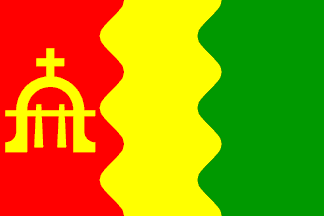
by Thanh-Tâm Le, 12 Febuary 2000

Last modified: 2021-08-25 by rob raeside
Keywords: puerto rico | loiza |
Links: FOTW homepage |
search |
disclaimer and copyright |
write us |
mirrors

by Thanh-Tâm Le, 12 Febuary 2000
See also:
The Lexjuris
site image is not consistent with the text as regards the
order of colours and the width of stripes, and this image follows
the text. This city of 30,000 inhabitants was founded in 1692
(new municipality in 1970). The red and yellow represent our
Spanish heritage, since they belong to the Spanish flag. Green
represents the tradition of San Patricio en Loíza [Loi'za]. The
three stripes separed by waves [ohoh] represent our geographic
profile, characterized by the fact that we are a coastal town,
and also have the river with the greatest width and flow in
Puerto Rico. The bell-tower shape represents our religious
tradition and also serves as a symbol of San Patricio Church as a
historical monument.
Thanh-Tâm Le, 14 January 1999
At first it seems that the flag
at pueblos-de-puertorico.com site (defunct) is about the same
as the one at Lexjuris
site but it does show a quite significant difference: the
symbol on the left on the Lexjuris site has two poles bungling in
a kind of gate, while on the pueblos-de-Puerto Rico site the
poles have been replaced by bells and the gate is miraculously
transformed into a bell-tower. That seems to be the 'Iglesia San
Patricio'. Loiza is a few km east of San Juan; it was founded
1692; a new municipio was formed 1970. There are 30,000 inh.
Jarig Bakker , 1 Febuary 2000
From <www.ngw.nl>:
"The upper half of the arms shows the local patron saint,
St. James on his horse. The wavy bar symbolises the Rio Grande de
Loiza river. The crown is a symbol for the local woman chief
Luysa, after which the town is named. The bordure shows some
flames, symbol of the Holy Spirit, and trefoils, symbol of the
other local patron saint, St. Patrick of Ireland."
Nelson Román, 8 July 2004